Visit the art blog at thematicconversion.tumblr.com and the relog blog at evtrained.tumblr.com.
92 posts
03 Of 05 - Modern Compendium: Deity Family, Part 2 - Fairy Peter Pan
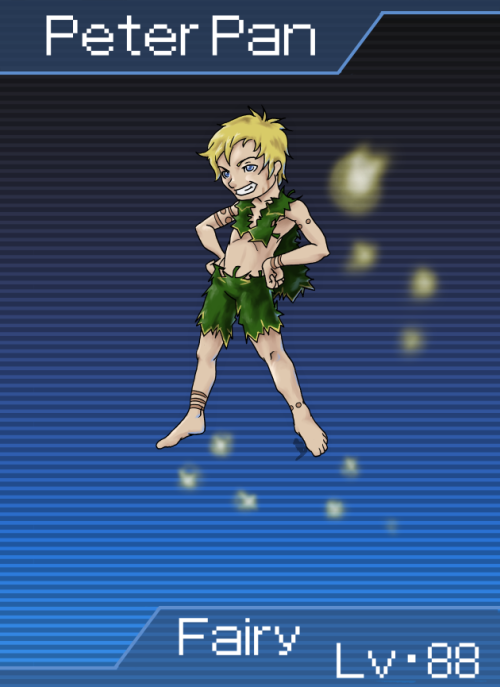
03 of 05 - Modern Compendium: Deity Family, Part 2 - Fairy Peter Pan
Though most people today know this fey youth through the popular Disney film, Peter Pan actually started out life as the brainchild of a Scottish novelist named J. M. Barrie. Barrie based Peter in large part on his older brother, who died at a very young age, but large parts of the character were also influenced by traditional fairy stories. In particular, Peter was supposed to have “left” his parents as a baby, only to come back later and find another child in his place, an element that strongly resembles the stories about Changelings, creatures of fae origin left in place of human children. And of course the idea of an eternally young human raised by fairies is a fairly common motif in fairy stories.
Like Jack Frost, Peter Pan has experienced a significant increase in popularity thanks to his inclusion in the canon of popular culture. These days, most people see Peter as a slightly mischievous, but usually heroic figure. However, his initial characterization was a bit more complex. Written as an exaggerated stereotype of a boastful and arrogant child, the original Peter Pan more or less personifies the arrogance of youth. One way this surfaces is in the way Peter retains his immortality, sacrificing his memories and experiences in order to remain young.
Peter was a pretty challenging demon to design, thanks to the great influence Disney has had in molding ideas about him. It was difficult to come up with a design that would include that source as an influence, but still look like it fit in a Shin Megami Tensei universe. In the end, I tried to go for a design that emphasized Peter’s feral arrogance, but still retained some whimsy and humanity.
Peter’s near ubiquity in the cultural lives of children means he’s a very robust figure in the Fairy family, coming in right at the top. He gets some very strong skills, but thanks to the Fairy family’s low power overall, he’s not overwhelming. I like to think Peter would be one of your first real end-game demons.
For more info on this and every other demon in the Modern Compendium, have a look at our Data File, right over (here)!
-
 kinemax liked this · 8 years ago
kinemax liked this · 8 years ago -
 smallfluffydigbee reblogged this · 9 years ago
smallfluffydigbee reblogged this · 9 years ago -
 smallfluffydigbee liked this · 9 years ago
smallfluffydigbee liked this · 9 years ago -
 historyclasses reblogged this · 10 years ago
historyclasses reblogged this · 10 years ago -
 suspiroatroz liked this · 10 years ago
suspiroatroz liked this · 10 years ago -
 carabbit liked this · 10 years ago
carabbit liked this · 10 years ago -
 xerozohar liked this · 10 years ago
xerozohar liked this · 10 years ago
More Posts from Historyclasses
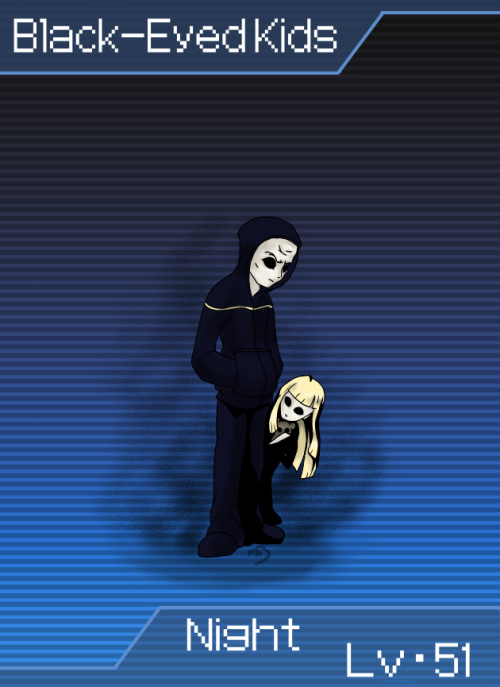
04 of 05 - Modern Compendium: Deity Family, Part 2 - Night Black-Eyed Kids
A redesign of one of our first demons from way back in 2012 (which can be seen [here]), Black-Eyed Kids is a myth that hasn’t actually moved very much in three years. It’s still fairly popular on the internet, and has actually gained some notariety in the minds of the general public. Stories of creepy children showing up in the middle of the night and demanding to be let in now occasionally show up on the same cable shows that showcase the spiritual tribulations of middle-aged housewives and paranormal investigators.
One of the ways Black-Eyed Kids have changed in the last three years is actually really bizarre; an explosion in the number of supposed explanations for this critter. When Black-Eyed Kids first appeared on the scene, there was little attention paid to the origins of these creepy munchkins. People were far more interested in simply relating stories of threatening teenagers than in where they came from. Today, however, we have “experts” theorizing that Black-Eyed Kids are everything from demons, to vampires, to government experiments gone horribly wrong. My personal favorite amongst these theories is the one that says Black-Eyed Kids are actually the end (or near-end) product of a decades-long human-alien hybridization project carried out by the Grey aliens. I await with baited breath the young adult paranormal romance novel about the teenage girl who falls in love with the mysterious escaped human-alien hybrid. ^^
Unexpectedly, Black-Eyed Kids would actually fit into a number of families. Their internet birthplace means they’d fit nicely into the memetastic Vile family, while their sinister alien background means they’d fit into several alien-based groups, including a couple we haven’t seen yet. But as critters of dubious cultural origin who are mostly associated with the dark, Black-Eyed Kids slot comfortably into the Night family.
For more info on this and every other demon in the Modern Compendium, have a look at our expanding and esoteric Data File, right over (here).
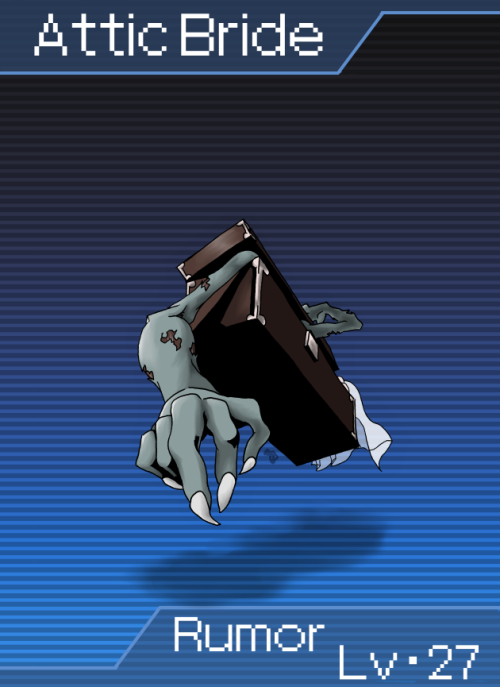
04 of 05 - Modern Compendium: Deity Family, Part 3 - Rumor Attic Bride
A popular and deceptively old urban legend, the story of the Bride in the Attic is one of those stories that gets told around campfires and on Halloween for chills, but not many people actually take it seriously.
The myth itself tells the story of a woman who, after many years of waiting and longing for a husband, fell in love and married the man of her dreams. After a fairy tale wedding, their friends and family treated them to a big house party with all the trimmings. Eventually someone suggested that they play some party games, and they started with Hide and Seek. The bride ran to the attic and hid in an old steamer trunk, and waited for someone to find her.
But no one ever did. The door to the attic had shut behind her, and the trunk had locked as it fell down on top of her. The wedding guests looked and looked, but it wasn’t until years and years later, when her widowed husband finally died, that anyone thought to look in the old trunk in the attic.
The story itself has a huge number of variations. Some versions have the husband as a sinister man who intended the bride to be locked in the attic, but he never gets his hands on her wealth because her vengeful spirit comes back to haunt him. Other versions have the husband himself finding the bride weeks or months later, as she begins to smell. Often a beating heart or spooky thumps on the ceiling are involved. But the most common alteration to the story is the city in which it happens; most people make sure the story takes place “just down the road” or “in a town just like this one” for maximum fireside spookies.
The Attic Bride fits easily into the Rumor family, but because it’s not a story that many people take very seriously, it’s not a particularly powerful demon. She is one of the few Rumors that is weak to Dark, though, so the Bride does have one unique thing to her credit.
For more info on this and every other demon in the Modern Compendium, have a look at our expanding Data File, right over (here.)
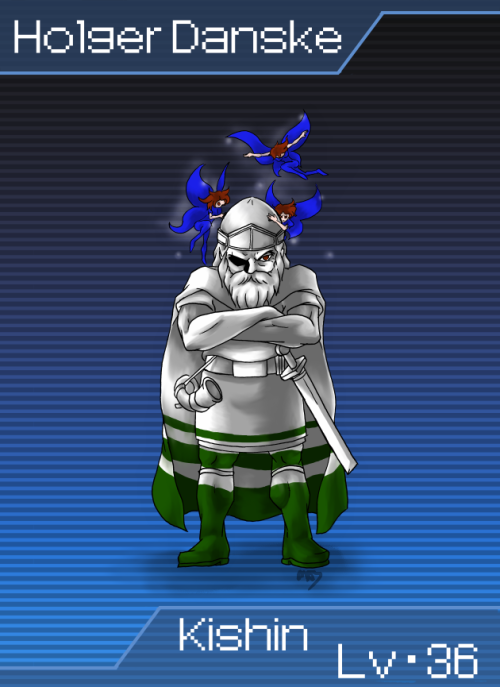
05 of 05 - Modern Compendium; Kishin Family, Part 3 - Kishin Holger Danske
A symbol of national pride and resilience, Holger Danske, also called Ogier the Dane, is about as pure a Kishin as you can find for the people of Denmark. He first entered the mythological lexicon of northern Europe in the 11th century, in the epic poem The Song of Roland. Holger appears as one of Charlemagne’s knights, leading a column of men against the enemy. Though he rarely stood out from other characters in the poems and stories he appeared in, Holger Danske quickly became a fan favorite of the Dutch people, leading him to appear in numerous stories up until the present day.
The most significant of these, at least for our purposes, is an opera called Holger Danske. The opera tells the story of yet another quarrel between Titania and Oberon, one so bad that Titania will only return if Oberon can find a human who exhibits all the qualities of loyalty and faithfulness that she says he lacks. Oberon happens upon Holger, who is on his way to the middle east to serve a penance for killing one of Charlemagne’s sons, and the two begin to work together. Anyway, long story short, Holger tricks a Sultan and defies burning at the stake to win the hand of his daughter in marriage.
Holger Danske was actually a fairly unpopular opera for its time, but the thematic elements of its music, which rejected German influence in Dutch culture, found a chord with the public during the Nazi occupation in 1941. Holger Danske became something of a rallying cry for the Dutch Resistance, to the point where one of the larger Resistance groups – about 350 veteran soldiers – actually called themselves the Holger Danske.
Anyway, Holger hangs around the middle of the Kishin family, but he’s really an exemplar of the group. He’s tough, offensive, and packs a very useful Physical resistance despite his low level. Definitely a solid choice for an early-mid game tank. ^^b
For more information on this and every other demon in the Modern Compendium, have a look at our Data File, right over (here).
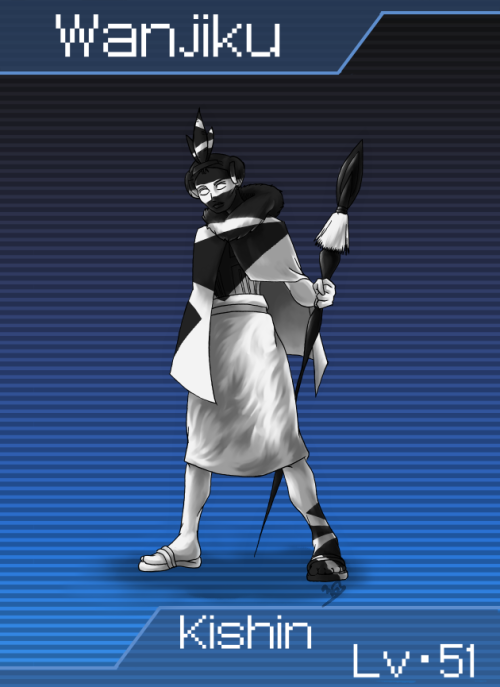
05 of 05 - Modern Compendium: Kishin Family, Part 5 - Kishin Wanjiku
There really is nothing more revealing about a national identity than the figures and ideals they use to represent them. For example, when the United States of the 1950s saw Uncle Sam, they knew they were looking at a paternalistic figure, a figure of authority with just a hint of familial affection. So when the people of Kenya chose to refer to the common man in the street as Wanjiku, it represents an interesting insight into their national identity.
The name Wanjiku comes from the origin myths of the Agikuyu tribe, one of the largest ethnic groups in Kenya. They say that the first man and woman, known as Gikuyu and Mumbi, were created by God and had nine children. Wanjiku was one of these children, and later went on to found the Agikuyu tribe.
Interestingly, the practice of referring to the general public of Kenya as Wanjiku is a relatively recent thing. It seems that during a crisis, former president Daniel arap Moi dismissed calls for a new constitution by saying, “Do you think Wanjiku understands what is a constitution?” Which, frankly, makes the whole thing downright hysterical in my eyes. You have to have a wonderful little contrarian streak to take a name hurled at you as an insult and turn it into the personification of your country.
Though Wanjiku is quite popular in her home country, knowledge of this figure is in no way wide-spread. Because of this, she hovers around the middle of the Kishin family. She does have a nicely broad selection of skills to learn, though, so it’s not a total loss.
For more info on this and every other demon in the Modern Compendium, have a look at our ever expanding Data File, right over (here).
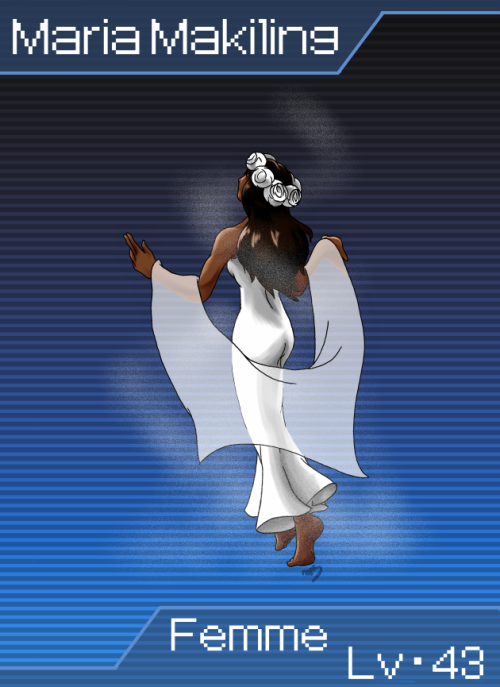
05 of 05 - Modern Compendium: Deity Family, Part 2 - Femme Maria Makiling
A major figure in the folk mythology that surrounds Mount Makiling in the central Philippenes, Maria Makiling is what is known as a Diwata, nature spirits roughly analogous to a nymph or fairy. Maria herself has roots that go back to the native cultures that inhabited the islands of the Philippenes before the European invasions, but as far as we can tell, she has always been seen as a protector of the mountain and surrounding areas.
What I find fascinating about Maria Makiling is how little the modern world has changed her. People that live around Mount Makiling still report seeing a dark haired, dark skinned woman in white wandering the wilderness, aiding those who respect and revere nature, and cursing those who despoil it. She’s even said to confuse those who don’t clean up after their campfires and picnics, turning the forest into an inescapable maze until they tidy up after themselves.
As an eternally young woman who is constantly pursued, but who only allows those she deems worthy to find her, Maria Makiling is eminently suited to the Femme family. Her kind nature does make her a bit of an unusual figure in the normally very offensively-focused Femme family; she’s more interested in healing spells and a few status effects than in actually dealing damage.
For more info on as well as links to every demon in the Modern Compendium, have a look at our extensive Data File, right over (here).